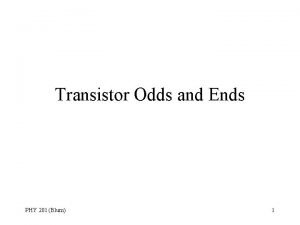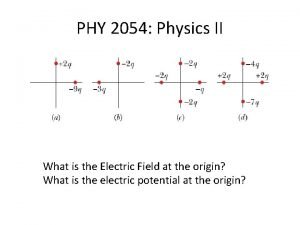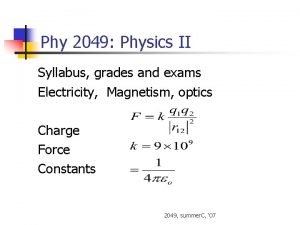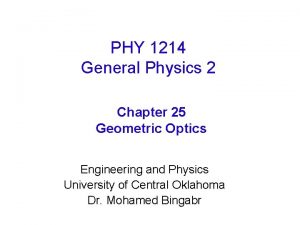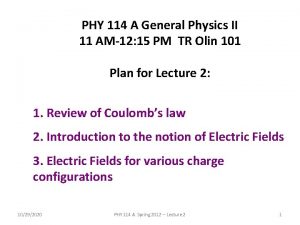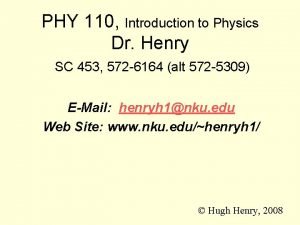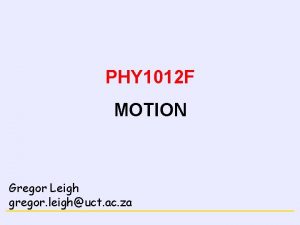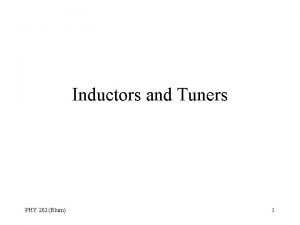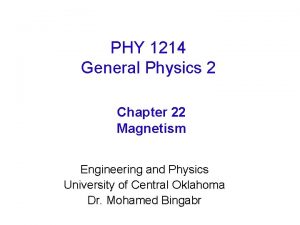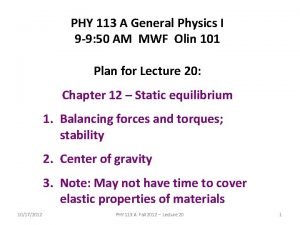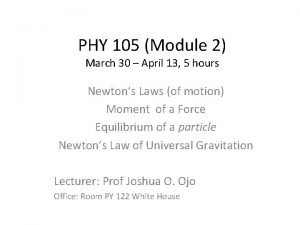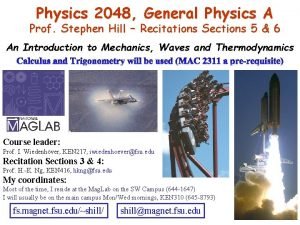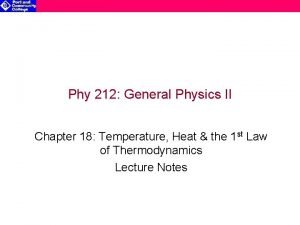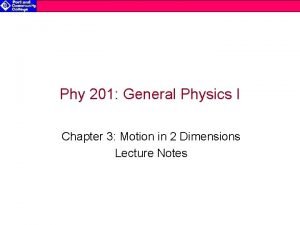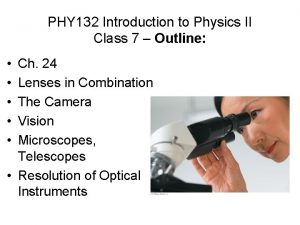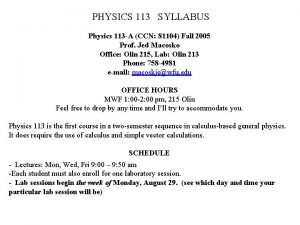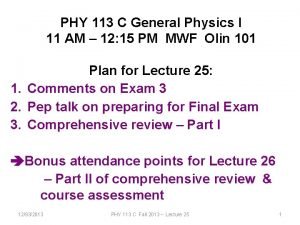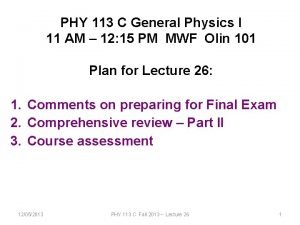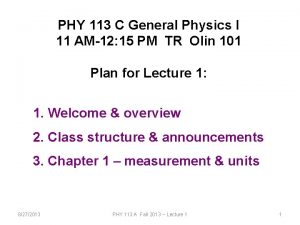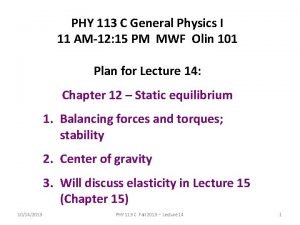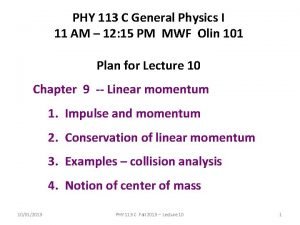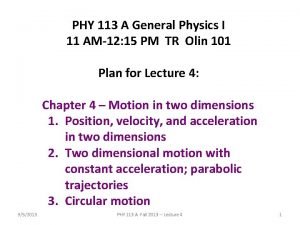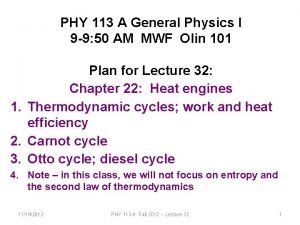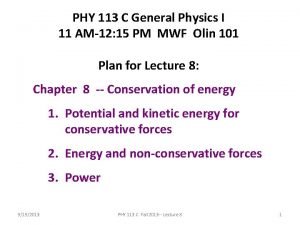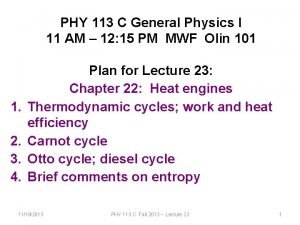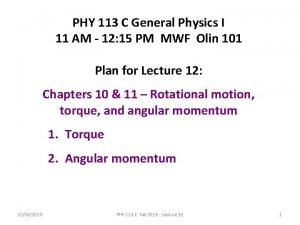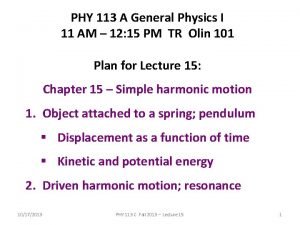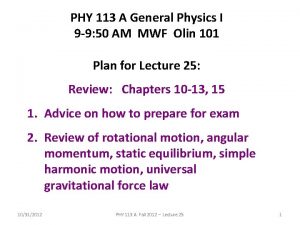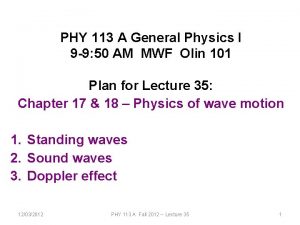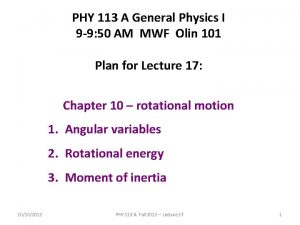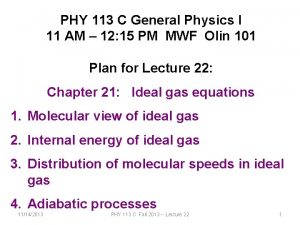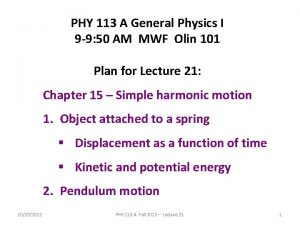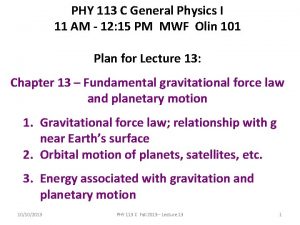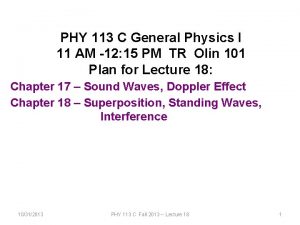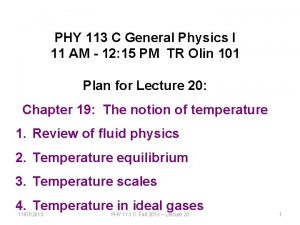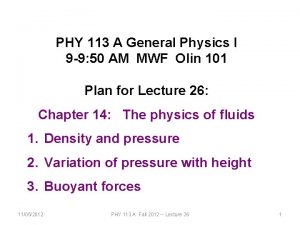PHY 113 C General Physics I 11 AM
































- Slides: 32

PHY 113 C General Physics I 11 AM – 12: 15 PM TR Olin 101 Plan for Lecture 2: Chapter 2 – Motion in one dimension 1. Time and Position 2. Time and Velocity 3. Time and Acceleration 8/29/2013 4. Special relationships for constant acceleration PHY 113 C Fall 2012 -- Lecture 2 1

Some updates/announcements 8/29/2013 PHY 113 C Fall 2012 -- Lecture 2 2

iclicker exercises: Webassign Experiences so far A. B. C. D. Have not tried it Cannot login Can login Have logged in and have completed one or more example problems. Textbook Experiences A. B. C. D. E. 8/29/2013 Have no textbook (yet) Have complete physical textbook Have electronic version of textbook Textbook is on order Other PHY 113 C Fall 2012 -- Lecture 2 3

Comment on Webassign #1 problem: 7. A pet lamb grows rapidly, with its mass proportional to the cube of its length. When the lamb's length changes by 16%, its mass increases by 16. 8 kg. Find the lamb's mass at the end of this process. Problem solving steps 1. Visualize problem – labeling variables 2. Determine which basic physical principle(s) apply 3. Write down the appropriate equations using the variables defined in step 1. 8/29/2013 4. Check whether you have the correct amount of information to solve the problem (same number of knowns and unknowns). 5. Solve the equations. 6. Check whether your answer makes sense (units, order of magnitude, etc. ). PHY 113 C Fall 2012 -- Lecture 2 4

7. A pet lamb grows rapidly, with its mass proportional to the cube of its length. When the lamb's length changes by 16%, its mass increases by 16. 8 kg. Find the lamb's mass at the end of this process. L 8/29/2013 PHY 113 C Fall 2012 -- Lecture 2 5

i>clicker exercise: What did you learn from this problem? A. B. C. D. E. 8/29/2013 It is a bad idea to have a pet lamb This was a very hard question I hope this problem will not be on an exam My physics instructor is VERY mean All of the above. PHY 113 C Fall 2012 -- Lecture 2 6

Motion in one-dimension 8/29/2013 PHY 113 C Fall 2012 -- Lecture 2 7

Graphical representation of position (displacement) x(t) t (s) 8/29/2013 PHY 113 C Fall 2012 -- Lecture 2 8

Comment: Your text mentions the notion of a “scalar quantity” in contrast to a “vector quantity” which will be introduced in Chapter 3. In most contexts, a scalar quantity – like onedimensional distance or displacement can be positive or negative. Another comment: Your text describes the time rate of change of displacement as “velocity” which, in one-dimension is a signed scalar quantity. In general “speed” is the magnitude of velocity – a positive scalar quantity. 8/29/2013 PHY 113 C Fall 2012 -- Lecture 2 9

Graphical representation of position (displacement): x(t) time rate of change of displacement = velocity: v(t) t (s) 8/29/2013 PHY 113 C Fall 2012 -- Lecture 2 10

Instantaneous velocity v. B v. A v. C v. D v. E v. F t (s) 8/29/2013 PHY 113 C Fall 2012 -- Lecture 2 11

Demonstration of tangent line limit 8/29/2013 PHY 113 C Fall 2012 -- Lecture 2 12

Average velocity versus instantaneous velocity 8/29/2013 PHY 113 C Fall 2012 -- Lecture 2 13

Average velocity iclicker exercise: This results is: A. Exact B. Approximate 8/29/2013 PHY 113 C Fall 2012 -- Lecture 2 14

Webassign Example 8/29/2013 PHY 113 C Fall 2012 -- Lecture 2 15

Instantaneous velocity using calculus x v 8/29/2013 PHY 113 C Fall 2012 -- Lecture 2 16

Anti-derivative relationship x t 8/29/2013 PHY 113 C Fall 2012 -- Lecture 2 17

Velocity 8/29/2013 PHY 113 C Fall 2012 -- Lecture 2 18

Acceleration 8/29/2013 PHY 113 C Fall 2012 -- Lecture 2 19

Rate of acceleration iclicker exercise How many derivatives of position are useful for describing motion: A. 1 (dx/dt) B. 2 (d 2 x/dt 2) C. 3 (dx 3/dt 3) D. 4 (dx 4/dt 4) E. 8/29/2013 PHY 113 C Fall 2012 -- Lecture 2 20

Anti-derivative relationship 8/29/2013 PHY 113 C Fall 2012 -- Lecture 2 21

Examples v(t) x(t) 8/29/2013 PHY 113 C Fall 2012 -- Lecture 2 22

Examples v(t) x(t) 8/29/2013 PHY 113 C Fall 2012 -- Lecture 2 23

Summary 8/29/2013 PHY 113 C Fall 2012 -- Lecture 2 24

Another example x(t) v(t) 8/29/2013 PHY 113 C Fall 2012 -- Lecture 2 25

From webassign: 8/29/2013 PHY 113 C Fall 2012 -- Lecture 2 26

Another example (m/s) (s) 8/29/2013 PHY 113 C Fall 2012 -- Lecture 2 27

Another example -- continued (m/s) (s) 8/29/2013 PHY 113 C Fall 2012 -- Lecture 2 28

Special relationships between t, x, v, a for constant a: 8/29/2013 PHY 113 C Fall 2012 -- Lecture 2 29

Special relationships between t, x, v, a for constant a: 8/29/2013 PHY 113 C Fall 2012 -- Lecture 2 30

Special case: constant velocity due to earth’s gravity In this case, the “one” dimension is the vertical direction with “up” chosen as positive: a = -g = -9. 8 m/s 2 y(t) = y 0 + v 0 t – ½ gt 2 y 0 = 0 v 0 = 20 m/s At what time tm will the ball hit the ground ym = -50 m ? Solve: ym = y 0 + v 0 tm – ½ gtm 2 quadratic equation physical solution: tm = 5. 83 s 8/29/2013 PHY 113 C Fall 2012 -- Lecture 2 31

Helpful mathematical relationships (see Appendix B of your text) 8/29/2013 PHY 113 C Fall 2012 -- Lecture 2 32
 Phy 113 past questions and answers
Phy 113 past questions and answers Phy 131 past papers
Phy 131 past papers Pa msu
Pa msu Great orthogonality theorem
Great orthogonality theorem Phy 221 msu
Phy 221 msu Phy theorem
Phy theorem Phy 121 asu
Phy 121 asu Ddr phy architecture
Ddr phy architecture Phy 205
Phy 205 Site:slidetodoc.com
Site:slidetodoc.com Phy 2049
Phy 2049 Physics 2
Physics 2 Phy
Phy Phy
Phy Atm packet phy
Atm packet phy Fizik ii
Fizik ii Phy 2049
Phy 2049 General physics
General physics Phy 1214
Phy 1214 Phy
Phy Phy 110
Phy 110 Complete motion diagram
Complete motion diagram Felix connects a wire coil to an ammeter
Felix connects a wire coil to an ammeter Life phy
Life phy Rikard blunck
Rikard blunck General physics
General physics 2012 phy
2012 phy Phy-105 5 discussion
Phy-105 5 discussion Stephen hill fsu
Stephen hill fsu Phy 212
Phy 212 Phy 1214
Phy 1214 Phy 1214
Phy 1214 Nearsightedness physics
Nearsightedness physics













